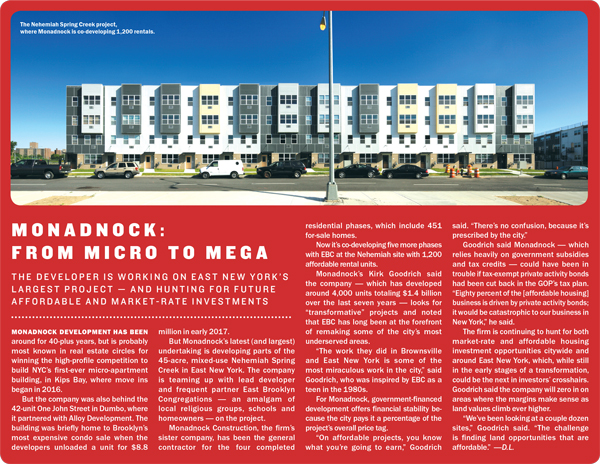Trending
Why investors are flocking to East New York
Affordable housing is where profits are currently penciling out, but questions are swirling about when the area will be ready for market-rate

When Brooklyn’s East New York was rezoned in 2016, it touched off a real estate makeover.
That year, developers filed applications for 339 residential units. But in 2017 that number shot up by 284 percent to 1,303 units — many of them heavy on the affordable housing.
A handful of developers have gotten in on the ground floor.
Multifamily developer Radson Development is preparing projects for two vacant lots: one a 235-unit mixed-use, 12-story building on Linden Boulevard, the other a 521-unit affordable housing-and-retail complex on Loring Avenue.
Meanwhile, Monadnock Development, the East Brooklyn Congregations and the Department of Housing Preservation and Development filed plans in September for a 240-unit affordable rental development as part of the sprawling Nehemiah Spring Creek development, which sits on city-owned land adjacent to the Gateway Center shopping mall.
And Phipps Housing is diving in with a 403-unit affordable housing complex on Atlantic Avenue in Cypress Hills, a section of East New York.
Though some of those developments are outside of East New York’s rezoned area — which includes about 190 blocks, roughly between Fulton and Belmont avenues — competition for investment properties in the area is strong.
That may be because residential prices in East New York have shot up 45 percent since 2012 — the same sort of jump being logged in pricey Brooklyn neighborhoods like Carroll Gardens and Park Slope, according to PropertyShark.
“There’s a lot of cash buyers coming in looking for good deals, mostly for [two- and three-family homes they can rent out] anywhere under the million-dollar range,” noted Citi Habitats broker Kendall Vidal, who said he has 20 interested parties for one property he’s selling in the neighborhood.
Investors are “super interested in the area,” partly because they are banking on the fact that buyers and renters will increasingly get priced out of other areas and turn to East New York as a cheaper alternative.
The neighborhood — which is on six subway lines and the Long Island Rail Road — is a short train ride from Bushwick and Bedford-Stuyvesant, where rents shot up by 44 percent and 36 percent, respectively, between 1990 and 2014. But it has a different genetic makeup.
“A lot more rental units in East New York are rent-stabilized and rent-controlled than in Bushwick and Bed-Stuy,” said Ideal Properties Group’s Aleksandra Scepanovic.
Real estate players say that for now, affordable housing is where profits are penciling out. That’s thanks largely to the availability of tax-exempt bonds and government subsidies.
“I don’t see a huge rush of for-profit buying at these prices to build market-rate housing,” said Alan Bell, a principal at B&B Urban, which is building a 100-unit affordable rental project in the area.
Bell, whose firm invested before the rezoning was finalized and land prices shot up, said he’s not sure whether B&B could make the project work financially now. In some cases, property owners are looking for prices between $70 and $80 per buildable square foot, he said. That’s almost twice the roughly $43 average the neighborhood was seeing in 2014, according to TerraCRG.
“Owners of property are going to have to get more realistic, [and] when it happens I’ll be ready to jump,” Bell said.
In general, East New York is not without its warts. While crime has fallen 73 percent since 1990, more major crimes were committed in East New York and Cypress Hills than in any other precinct citywide in 2017. And crime there was twice what Williamsburg and Bed-Stuy saw, according to the NYPD.
And commercial sales volume has not seen the same bump as residential. While there was $155.5 million in commercial deals in 2017 — a 27 percent increase from 2008 — the neighborhood peaked in 2015, when $274.8 million in property traded hands.
Bell said the first wave of market-rate housing will likely get built on smaller plots, where sellers may be more willing to drop prices. Those who own large parcels, he said, are more likely to wait for the big money to arrive down the road.
Click here to read more about outer borough areas that investors are running to in New York City.




